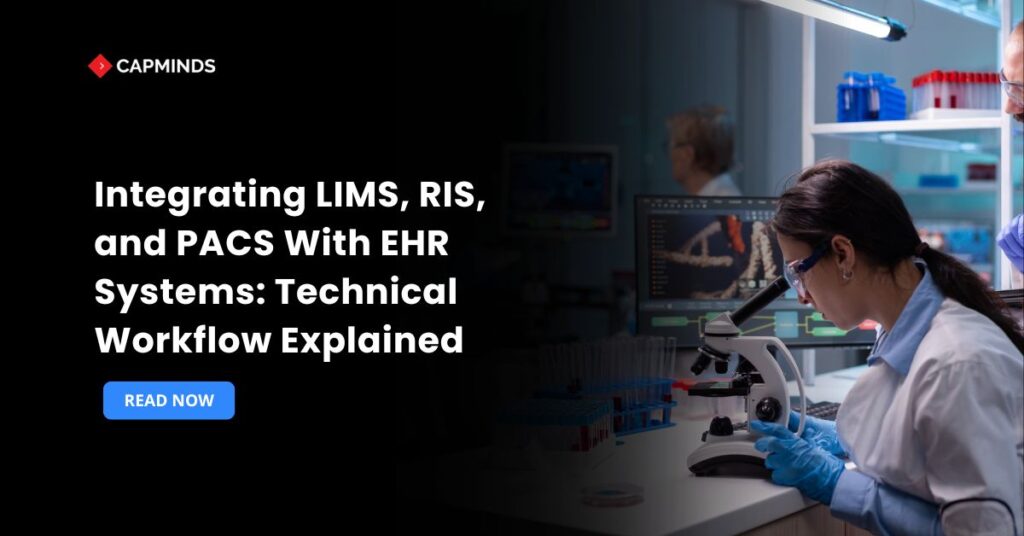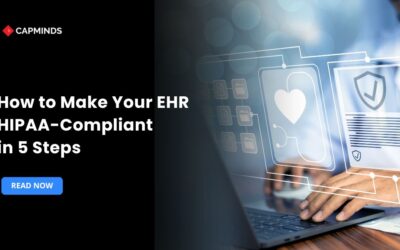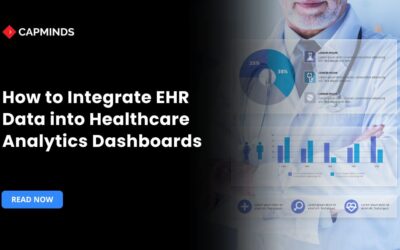Integrating LIMS, RIS, and PACS With EHR Systems: Technical Workflow Explained
The complexities of imaging and diagnostic information have increased, pushing healthcare organizations towards integrating LIMS, RIS, and PACS into their Electronic Health Record systems. Integration improves data consistency and enables better-informed decision-making, speeding up diagnoses and enhancing the quality of patient care.
Seamless data transmission between LIMS, RIS, PACS, and EHRs guarantees that doctors have real-time access to everything from lab findings to radiological images through a single interface.
In this blog, you’ll know the technical steps required for such integration, including interface standards, critical components, and practical implementation concerns.
Why Should PACS, RIS, and LIMS Be Integrated with EHR?
Clinical and operational benefits of diagnostic system integration with EHRs are substantial. Clinicians have to repeatedly retrieve lab or imaging results manually in the absence of integration, resulting in delays and increased risk. Integration does away with these inefficiencies by streamlining data flow.
- Improved patient safety and provides fast access to lab and imaging findings, lowering the risk of delayed diagnosis.
- Efficient processes remove data duplication and keying between departments.
- All clinical and diagnostic information is integrated into a composite picture of the patient through documentation.
- HIPAA, CLIA, and other regulations’ documentation and audit trails are ensured through regulatory compliance.
Core Systems Include LIMS, RIS, PACS, and EHR
Each diagnostic system has a distinct purpose in healthcare delivery, and knowing their roles is essential before trying integration.
- LIMS controls lab samples, monitors processes, saves test results, and maintains quality control.
- The RIS manages radiology scheduling, procedures, and reporting, which is critical for managing diagnostic imaging services.
- The PACS stores, retrieves, distributes, and displays medical images.
- The EHR maintains a central repository for patient information such as demographics, vitals, clinical notes, prescriptions, lab data, and imaging studies.
These systems establish a single ecosystem in a two-way, real-time data flow when correctly linked.
Standards and Protocols for Integration
Any integration must follow defined interoperability rules in order to succeed. These standards ensure that disparate systems “speak the same language” and are able to identify common transport methods and data formats.
- Lab results, orders, and reports are examples of structured data that may be sent between EHRs, LIMS, and RIS using HL7 v2/v3.
- A modern RESTful API standard, FHIR is being used more and more for transferring data in real time.
- DICOM is a standard for sending, storing, and displaying medical images between PACS and EHRs.
- IHE is a framework that uses HL7 and DICOM standards to standardize cross-vendor system communications.
Healthcare technologies and manufacturers may communicate and scale by using these standards.
Technical Integration Workflow: Step-by-Step
A strong integration architecture usually includes the following technological workflow.
1. Order Initiation from EHR
The process begins when a physician requests a lab test or an imaging procedure via the EHR. Order messages are often transmitted to LIMS or RIS using HL7 ORM (Order Entry) messages.
2. Order Processing and Execution
In LIMS, samples are gathered and monitored as they progress through the testing process.
In RIS, the imaging scan is scheduled and carried out following procedures specific to the patient’s situation.
3. Data Capture and Storage
Lab findings are stored in a LIMS and sent as HL7 ORU messages. PACS stores imaging data in DICOM format, and RIS generates radiology reports.
4. Result Transmission and Integration into the EHR
- LIMS transmits test results to the EHR using HL7 ORU messages.
- RIS communicates structured reports often via HL7 or CDA documents, whereas PACS delivers DICOM pictures or image links.
- EHRs must be able to render DICOM viewers and connect to PACS for picture presentation.
5. Result Review and Clinical Decision-Making
The EHR interface provides clinicians with real-time access to lab and imaging findings, allowing for informed decision-making and recording.
Related: Implementing e-Prescribing, Lab Interfaces, and Imaging Workflows in OpenEMR
Integration Challenges and How to Overcome Them
Despite the significant benefits of integration, healthcare companies encounter a number of implementation challenges.
- Vendor Compatibility – Proprietary interfaces can impede interoperability.
- Complexity of Data Mapping – The customisation of HL7 and DICOM messages varies by vendor.
- Latency and Reliability – Real-time data synchronization necessitates strong network and server settings.
- Security and Privacy – HIPAA-compliant encryption and access restrictions must be implemented across all systems.
How to Mitigate These Challenges
- Collaborate with integration professionals who understand HL7, FHIR, and DICOM.
- Perform a comprehensive requirements analysis and interface specification review.
- Before going live, test the integration in sandbox environments.
- Control message transformation and data flow using integration engines like Mirth Connect.
Best Practices for a Successful Diagnostic and EHR Integration
- Standardize terminology by using LOINC for lab testing, SNOMED CT for clinical words, and RADLEX for radiology.
- Use Interface Engines to centralize integration logic and message transformations.
- Implement audit trails and monitor each communication for compliance and error handling.
- End-to-end testing involves validating data integrity across all system touchpoints.
Involve clinical stakeholders early in the design process to verify that the integration supports real-world operations.
Partner With CapMinds Seamless Diagnostic Integration
At CapMinds, we specialize in building powerful, interoperable ecosystems that connect diagnostic systems like LIMS, RIS, and PACS directly to your EHR.
Our end-to-end integration services help healthcare organizations eliminate data silos, reduce diagnostic delays, and achieve real-time clinical insights, all while ensuring compliance with industry standards.
With CapMinds, you get:
- LIMS Integration – Automate lab workflows and deliver test results directly into the EHR using HL7 interfaces.
- RIS Integration – Streamline radiology scheduling, reporting, and results sharing between systems.
- PACS Integration – Enable instant access to DICOM images within the EHR through secure, embedded viewers.
- EHR Customization & Interfacing – Build scalable, standards-based integrations using HL7, FHIR, and DICOM.
- Integration Engines – Implement reliable data transformation and routing with tools like Mirth Connect.
Ready to unlock seamless diagnostics and smarter care delivery?
Contact CapMinds today for a tailored integration strategy that connects every piece of your digital health infrastructure.




